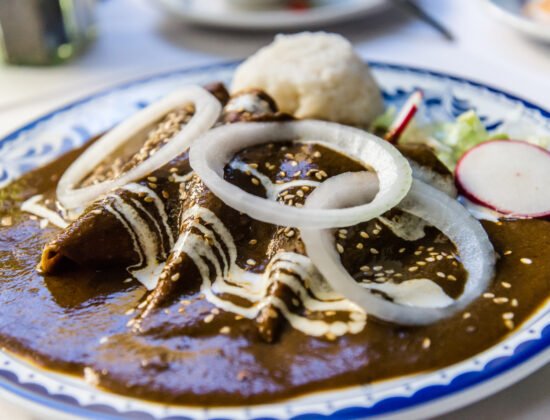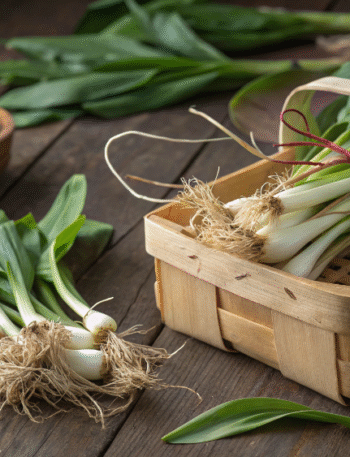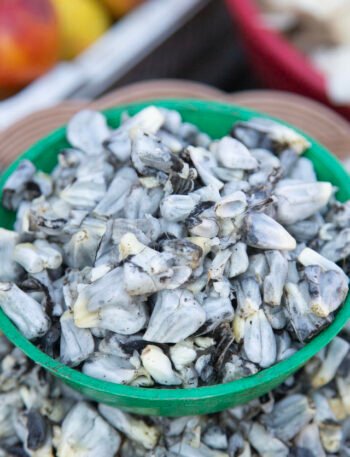When people talk about Mexican food, one word that often comes up is mole. But mole is not just one sauce. It is a whole family of sauces with deep roots, long cooking times, and layers of flavor. Two regions in Mexico, Oaxaca and Puebla, both claim to be the true home of mole. Each has its own history, traditions, and recipes, and both are proud of their role in making mole what it is today.
Let’s explore what mole is, how it is made, why it matters, and how versions of it appear outside of Mexico too.
What Is Mole?
Mole (pronounced MOH-lay) is a thick, richly flavored sauce made from a blend of ingredients like dried chiles, nuts, seeds, spices, fruits, and sometimes chocolate. It is most often served over meats like chicken, pork, or turkey. The ingredients vary depending on the region and the cook, but most moles are slow-cooked, carefully layered, and packed with flavor.
Mole is more than just a dish. It is often made for special occasions like weddings, holidays, and religious festivals. Families may spend an entire day preparing it, turning the kitchen into a place of shared work, stories, and tradition.
Oaxaca and Puebla: Who Owns Mole?
Both Oaxaca and Puebla say they are the true birthplace of mole. In Puebla, people point to mole poblano, a dark and slightly sweet mole made with chiles, spices, and chocolate, usually served with turkey or chicken. Many consider this the original mole, and it is often served at major celebrations.
Oaxaca is known for its variety of moles and is often called “the land of the seven moles.” Each of these sauces has its own flavor, ingredients, and color. People in Oaxaca see mole as an essential part of their culture and everyday life.
Instead of picking sides, it may be more accurate to say that both regions have helped develop mole into the rich, beloved part of Mexican cuisine that it is today.
The Seven Moles of Oaxaca
Oaxaca’s seven traditional moles are known for their depth and diversity. Some are spicy, some are earthy, and some are slightly sweet. Each one tells a story, not just about flavor, but about the region’s Indigenous roots, colonial history, and culinary creativity.

Oaxaca is one of the most culturally rich states in Mexico. It is home to several Indigenous groups, including the Zapotec and Mixtec peoples, who have lived in the region for thousands of years. These groups have long traditions of cooking with native herbs, seeds, and chiles, all of which play a major role in mole. When Spanish colonizers arrived in the 16th century, they brought with them new ingredients such as nuts, spices from Asia, and domesticated animals like chickens and pigs. Over time, local cooks began blending these new ingredients with native techniques to create complex sauces that we now call mole.
In Oaxaca, mole is more than just food. It is a cultural symbol. You can find these sauces served at weddings, religious festivals, family gatherings, and village celebrations. Each of the seven moles has a unique place in Oaxacan cuisine and tradition. Some are tied to specific holidays, while others are used for everyday meals. Preparing them often takes hours, sometimes even days, and families may pass down recipes for generations.
Let’s take a closer look at each of the seven:
Mole Negro (Black Mole)
This is the most famous mole in Oaxaca. It includes dried chiles, spices, nuts, seeds, and a small amount of chocolate. The sauce is dark, smooth, and packed with complex flavor. It takes many hours to make and is often served on very special occasions.
Mole Rojo (Red Mole)
This version uses red chiles, tomatoes, and spices. It is bold and full of heat. Mole rojo is often paired with pork or beef.
Mole Coloradito
Lighter than mole negro but still rich, coloradito uses red chiles, tomatoes, plantains, and a bit of chocolate. It has a balance of sweetness and spice and is good with chicken.
Mole Amarillo (Yellow Mole)
This mole uses yellow chiles and sometimes masa (corn dough) as a thickener. It is usually served with chicken and vegetables and has a more mild and herbal taste.
Mole Verde (Green Mole)
Mole verde gets its color from fresh herbs like cilantro, epazote, and hoja santa, along with pumpkin seeds. It is fresh, grassy, and lighter than the darker moles. It is often served with pork or chicken.
Mole Chichilo
This is one of the rarest moles. It uses burnt tortillas and avocado leaves for a smoky and slightly bitter flavor. It is usually served with beef.
Mole Manchamantel
The name means “tablecloth stainer,” and it is easy to see why. This mole includes pineapple, plantains, and chorizo. The result is a sweet and spicy sauce that stands out from the others.
Sweet and Savory Sides of Mole
Many people think of mole as a savory sauce, but some moles lean toward the sweet side. Mole manchamantel has pineapple and plantains. Mole poblano includes chocolate. Other recipes use raisins or prunes for added depth.
These sweet notes are not meant to turn mole into dessert, but they do help balance the heat from the chiles and the richness of the spices. In some parts of Mexico and Central America, mole is also served as a sweet dish. One example is plátanos con mole, a Guatemalan dessert where fried plantains are covered with a sweet mole-style sauce made with chocolate and spices. It is a good reminder that mole can be flexible and creative.
Mole Outside of Mexico
While mole is strongly linked to Mexican cuisine, similar sauces exist in other parts of Latin America. One well-known example is Pepián, a traditional Guatemalan sauce made with toasted seeds, dried chiles, tomatoes, and spices. Pepián is one of Guatemala’s oldest dishes and shares some similarities with mole, especially in how it builds flavor through toasting and blending.
If you want to explore pepián further, check out my recipe here and try making it at home.
These connections show how mole is part of a larger story of Latin American cooking, where regional ingredients and traditions shape each dish in unique ways.
Making Mole at Home
Making mole from scratch takes time and care. Some recipes include more than 20 ingredients, and the process can take several hours. It usually starts with toasting chiles, nuts, and seeds, followed by blending them with spices, broth, and sometimes fruit or chocolate. The sauce is then simmered until it becomes smooth and full of flavor.
If you are new to mole, you might start with a simpler version like mole verde or mole coloradito. These take less time than mole negro or mole poblano but still offer a great introduction to the flavors.
Some cooks use premade mole pastes from markets or stores. These can be a helpful shortcut, especially if you add your own ingredients to customize the taste.
Final Thoughts
Mole is more than just a sauce. It is a symbol of tradition, celebration, and the richness of Mexican and Central American culture. Whether you are enjoying mole poblano in Puebla, tasting one of the seven moles of Oaxaca, or trying Pepián or plátanos con mole in Guatemala, you are taking part in something meaningful and delicious.
Each version of mole reflects the ingredients, history, and personality of the region it comes from. No matter where you try it, mole has the power to turn an ordinary meal into something memorable.




